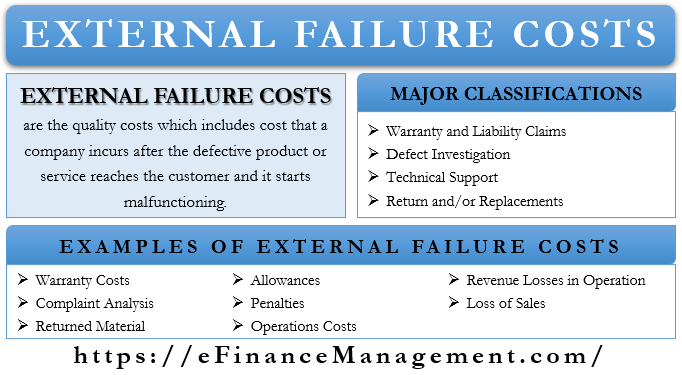External failure cost is one of the three types of cost of quality. It includes the cost a company incurs after a defective product or service reaches the customer and it malfunctions. Two common examples of this cost are warranty cost, cost of the return, and cost of return and replacement.
Additionally, if a customer sues the company for a defective product, then the legal and compensation costs will also be an external failure cost. There are also arguments that goodwill that a company loses due to a defective product could also be a part of the external failure cost. However, estimating and valuing the loss of goodwill is a difficult task. In accounting, we otherwise also talk about the events and transactions that can be measured and expressed in monetary values. Of course, this is non-measurable and looks non-monetary. But it can have a severe impact on the goodwill and credibility of the company and its products. And that, in turn, can have a substantial monetary dent to the demand and profits of the company.
Classification of External Failure Cost
Generally, we can summarize all sorts of external failure costs into four heads:
- Warranty and liability claims, recall – all that cost incurred as the product was under warranty, cost of defending any lawsuit, any penalty payable owing to the lawsuit, the cost of recall of products and sending back, etc.
- Defect investigation – complaint management, visit of the field staff, and understanding the reason or extent of the defect.
- Technical support – online or offline support for resolution of the defect.
- Returns and/or replacements – depending upon the status and condition of the defective product, either it is returned, and a refund needs to be processed, or replacement has to take place.
Examples of External Failure Cost
Let us now see and understand each of these external failure costs by way of our day-to-day examples:
Warranty Cost
These are the costs that a company incurs on replacing or reworking the defective product if it is under warranty.
Complaint Analysis
These include the costs that a company incurs on investigating or identifying defective product complaints from the total complaints.
Returned Material
It will include the costs to receive and replace a faulty product from the field.
Allowances
A company usually gives a customer some discount to encourage them to accept or buy the defective product.
Penalties
It includes the legal cost to defend the company or any penalty a company pays as a result of the lawsuit filed by the customer owing to the supply of a defective product.

Operations Cost
This is the cost that a company incurs to correct billing and other operational processes if a customer returns the faulty product.
Revenue Losses in Operations
When there is a defective product, a company needs to spend considerable time to make it good. So, the opportunity time loss (if quantifiable) of the operations team will come under this. For example, unable to timely collect payment from debtors.
Loss of Sales
A company may lose new and existing customers because of a defective product or service. Also, some customers may cancel their agreement with the company due to the defect.
Other Components of Cost of Quality
Following are the other three components of Cost of Quality (apart from the external failure cost):
Internal Failure Costs
Internal failure costs are the costs that a company incurs in making good the defects before delivering goods to a customer (or customers)—for example, scrap costs to rework and more.
Preventive Costs
Preventive cost is an age-old proverb that prevention is better than a cure. So, these include the costs a firm spends to avoid or minimize the faults or defects in the product or process—for example, training workers, an inspection team, and more.
Appraisal Costs
These are the costs specifically incur towards quality control. A company incurs appraisal costs to make sure its products and services conform to the quality standards. Also, these costs help to ensure that products or services meet government regulations and the expectations of the customers.
Final Words
The best way to minimize the external failure costs is to invest in prevention. And as well as assessing the quality at the time of production. Of course, investing in both prevention and in production appraisal would add to the cost. However, over time the saving from this investment would offset these costs (both internal and external failure costs). Moreover, with strict and vigilant monitoring, a lesser number of defective products would flow to the market. It would get a positive response from the customers and dealers. That will ultimately help the company enhance its goodwill, customers, and market share.

